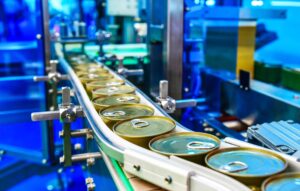01.02.2024
Energy Efficiency in Food Manufacturing
 In a world where the effects of climate change are being discussed in daily news broadcasts, producers of the food that we see on our supermarket shelves are presented with unique challenges. Retailers, other manufacturers who purchase ingredients and even restaurants are beginning to ask, “What is the carbon footprint, or the energy used, in the production of this food product?” Global pressure is mounting to create science-based carbon reduction goals to prevent heating of the world by more than 2 degrees Celsius, requiring companies to develop plans that eliminate 25-50% of their greenhouse gas (GHG) emissions in the next 6-10 years.
In a world where the effects of climate change are being discussed in daily news broadcasts, producers of the food that we see on our supermarket shelves are presented with unique challenges. Retailers, other manufacturers who purchase ingredients and even restaurants are beginning to ask, “What is the carbon footprint, or the energy used, in the production of this food product?” Global pressure is mounting to create science-based carbon reduction goals to prevent heating of the world by more than 2 degrees Celsius, requiring companies to develop plans that eliminate 25-50% of their greenhouse gas (GHG) emissions in the next 6-10 years.
Everyone clearly sees the need to act. To achieve the monumental sustainability goals that we have in the next decade, companies will need to look at a mix of energy conservation and optimization steps, generating or partnering on renewable energy assets, backed by data to efficiently drive the required changes to meet their goals.
In Lean manufacturing and continuous improvement, we use the Plan, Do, Check, Adjust (PDCA) cycle to drive continuous improvement. Most food manufacturers today do not know where their electricity and natural gas are being used after the utility main on their production floor. The right level of metering can help your facility in many ways:
- See what is running when it doesn’t need to be and turn it off.
- Determine where equipment can be slowed down or re-scheduled to save on energy usage and cut down peaks. After that, based on the new data, determine whether the expected benefit was achieved before you make more changes or investments.
- Find items that will cause downtime in the future like harmonics or near-overloaded panels.
- Know where you can expand, reconfigure, add renewables or add EV charging.
- Know where you have power quality issues and why.
- Track your sustainability goals and objectives in real time and lower your carbon footprint.
At Faith Technologies, we recommend installing a base level of permanent metering as a first step in most large facilities. This usually consists of:
- A power quality meter at each switchboard main.
- Energy metering for all loads out of each switchboard.
- Potential basic meters downstream for large loads or individual production lines (ideally that can be moved after energy usage is studied).
With this data, you’ll be able to see energy wasting areas that were hidden before – equipment and operating patterns that are wasting money and increasing your carbon footprint. Typical areas that you can expect to find conservation opportunities in are:
- HVAC zones and equipment.
- Similar process lines where some lines are much more energy-efficient (electrical or gas).
- Certain grades of product that take substantially more energy (electrical or gas) than others.
- Conveyance that can be slowed down when not moving product.
- Equipment that should not be running while production lines are down or over weekends.
- Air compression and vacuum systems that can be optimized.
- In general, systems that could be put in a controlled setback mode when they are not immediately needed.
Armed with energy meter information, your company will be able to accurately track:
- The carbon footprint equivalency of each product produced.
- Progress on driving down your carbon footprint with historical data.
- How changes to your operating patterns and equipment can drive more carbon and dollar savings.
In addition, you’ll be able to see where you might have power quality issues that could be damaging drives, motors or other electrical equipment. When it comes time to add another line, a new packaging module or a new forklift charger, your company will have clear data to understand how it will impact your energy usage and where in your existing distribution this equipment change could fit.
Finally, because conservation alone will not solve our global carbon issues long term, with this data, your company will be able to confidently right-size renewable energy resources and track the impact of the power generated by them. It will continue to give you a real-time dashboard of the decreasing carbon impact that your products have.
If you are interested in learning more about data-driven energy conservation, efficiency and renewables for your manufacturing facility, contact us today.
If you enjoyed this blog article, please subscribe to stay up to date on the latest industry news from our experts at Faith Technologies.



